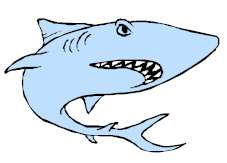Carcharodon Megalodon
What Happened to Them?
by
Harry Yingst

Carcharodon Megalodon - What a fantastic creature! They had grown to 60 feet long or more and weighted more than 20 tons. Having a voracious appetite, they had to eat at least 2 percent of their body weight daily to maintain their existence. What happened to this fish that lasted 16 million years beginning in the early Mid-Miocene and lasted until the Pliocene/Pleistocene Period? It seems that no one single incident bu several long developing changes occurred that brought about the Megalodon’s extinction.
Environmental changes were as important as any for the demise of this creature. By the late Miocene, about 10 million years ago, a period of major glaciation was under way. This was, it seems, the result of changes going back to the late Oligocene Period that began a slow cooling effect on the world. Changes like Africa colliding with Europe, cutting off the Tethyan Seaway to individual bodies of water represented today by the Mediterranean, Black, Caspian, and Aral seaways.
Also, the Indian subcontinent crashed into Asia, which formed the Himalayas. All these movements, over time, seriously altered global patterns of wind and rain which reduced the temperature at mid-latitudes by 27o Fahrenheit. This effect, in turn, brought about major glaciations at the Poles by the late Miocene. This glaciation resulted in the lowering of sea levels by about 650 feet.
Through lowered sea level and temperature, Megalodon lost large areas of suitable habitat. This is important because Megalodon lost much of its shallow nursery areas for its pups to grow and develop. Coincidentally, between 3.2 and 2.5 million years ago, the Isthmus of Panama rose from the sea floor, joining South America and North America. This new land bridge caused a great reduction of warm sea flow from the Pacific Ocean, thus helping to cool seas to less temperate waters favored by the Megalodon.
Predators also seemed to work against the Megalodon. Whales, Orcas in particular, which had been a mainstay in the Megalodon’s diet, had changed. Not only had they grown tremendously, they had become better swimmers with improved musculature and tail structure. Their developments allowed them to move or migrate from local areas to becoming migratory - ranging into Arctic waters, putting them out of reach of the warm water loving Megalodons for large parts of the year. So, it seems, the Orcas became better swimmers while growing to almost the size of the sluggish Megalodon.
The mature Megalodon was thus denied a major food source. Also, the Megalodon pups, over time had lost their shallow water protecting nurseries and became a snack for the faster Orcas. It would seem, in conclusion, that the adults were too large to get enough to eat and the juveniles were too small not to be eaten by the predators.
References:
Helm, Bill, Carcharadon Megalodon Extinction, elasmo.com.
Martin, R. Aidan, Explorations in Shark Evolution, ReefQuest Centers for Shark Research.
Stanley, Seven M., Extinctions, Johns Hopkins University, Scientific American Books, Inc.

Copyright © Georgia Mineral Society, Inc.
